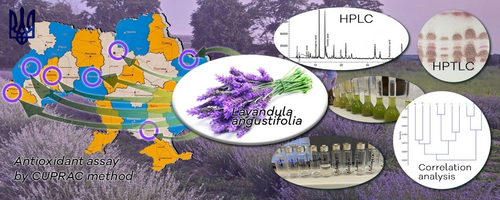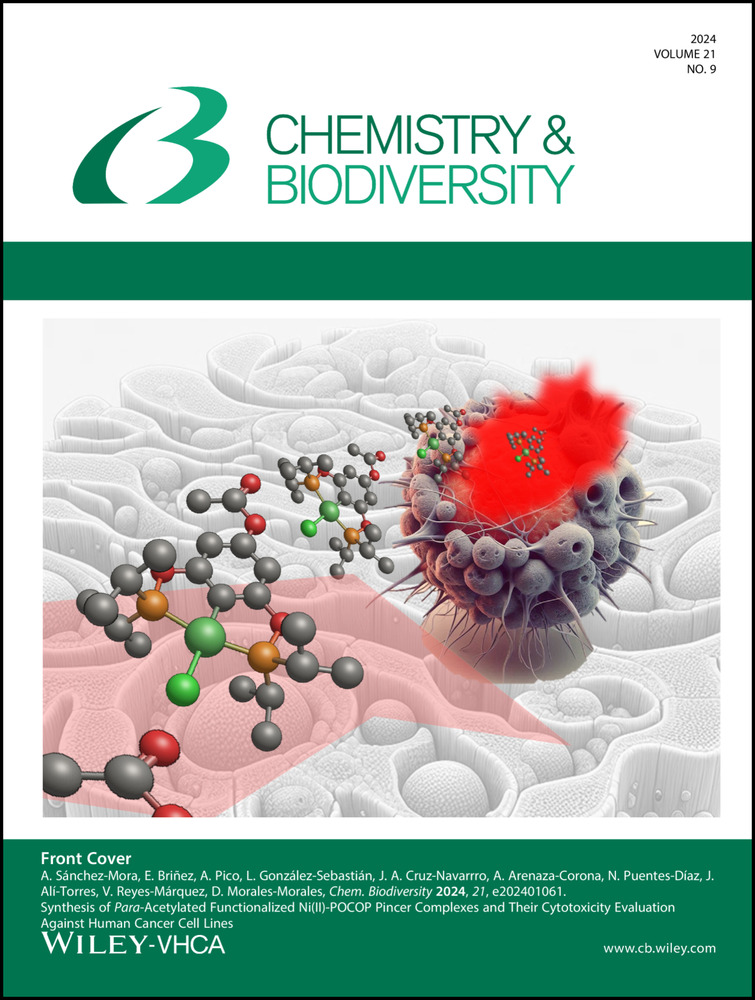Lavandula angustifolia Herb from Ukraine: Comparative Chemical Profile and in vitro Antioxidant Activity
Corresponding Author
Olha Mykhailenko
- [email protected]
- 380509277385
Department of Pharmaceutical Chemistry, National University of Pharmacy, 4-Valentynivska str., 61168 Kharkiv, Ukraine Tel: +
Pharmacognosy and Phytotherapy Group, UCL School of Pharmacy, 29-39 Brunswick Square, WC1 N 1AX London, United Kingdom
Search for more papers by this authorViktoriia Hurina
Department of Pharmaceutical Chemistry, National University of Pharmacy, 4-Valentynivska str., 61168 Kharkiv, Ukraine Tel: +
Search for more papers by this authorLiudas Ivanauskas
Department of Analytical and Toxicological Chemistry, Lithuanian University of Health Sciences, 9-A. Mickevičiaus g., 44307 Kaunas, Lithuania
Search for more papers by this authorMindaugas Marksa
Department of Analytical and Toxicological Chemistry, Lithuanian University of Health Sciences, 9-A. Mickevičiaus g., 44307 Kaunas, Lithuania
Search for more papers by this authorMariia Skybitska
Botanical Garden of the Lviv National Ivan Franko University, 44-Cheremshini str., 79000 Lviv, Ukraine
Search for more papers by this authorOleh Kovalenko
Mykolayiv National Agrarian University, Department of Plant Growing and Landscape Gardening, 9-Georgiy Gongadze st., 54000 Mykolaiv, Ukraine
Search for more papers by this authorDmytro Lytkin
Educational and Scientific Institute of Applied Pharmacy, National University of Pharmacy of Ministry of Health of Ukraine, 12 Kulykivska str., 61000 Kharkiv, Ukraine
Search for more papers by this authorInna Vladymyrova
Department of Pharmaceutical Technologies and Medicines Quality Assurance, National University of Pharmacy, 4-Valentynivska st., 61168 Kharkiv, Ukraine
Search for more papers by this authorVictoriya Georgiyants
Department of Pharmaceutical Chemistry, National University of Pharmacy, 4-Valentynivska str., 61168 Kharkiv, Ukraine Tel: +
Search for more papers by this authorCorresponding Author
Olha Mykhailenko
- [email protected]
- 380509277385
Department of Pharmaceutical Chemistry, National University of Pharmacy, 4-Valentynivska str., 61168 Kharkiv, Ukraine Tel: +
Pharmacognosy and Phytotherapy Group, UCL School of Pharmacy, 29-39 Brunswick Square, WC1 N 1AX London, United Kingdom
Search for more papers by this authorViktoriia Hurina
Department of Pharmaceutical Chemistry, National University of Pharmacy, 4-Valentynivska str., 61168 Kharkiv, Ukraine Tel: +
Search for more papers by this authorLiudas Ivanauskas
Department of Analytical and Toxicological Chemistry, Lithuanian University of Health Sciences, 9-A. Mickevičiaus g., 44307 Kaunas, Lithuania
Search for more papers by this authorMindaugas Marksa
Department of Analytical and Toxicological Chemistry, Lithuanian University of Health Sciences, 9-A. Mickevičiaus g., 44307 Kaunas, Lithuania
Search for more papers by this authorMariia Skybitska
Botanical Garden of the Lviv National Ivan Franko University, 44-Cheremshini str., 79000 Lviv, Ukraine
Search for more papers by this authorOleh Kovalenko
Mykolayiv National Agrarian University, Department of Plant Growing and Landscape Gardening, 9-Georgiy Gongadze st., 54000 Mykolaiv, Ukraine
Search for more papers by this authorDmytro Lytkin
Educational and Scientific Institute of Applied Pharmacy, National University of Pharmacy of Ministry of Health of Ukraine, 12 Kulykivska str., 61000 Kharkiv, Ukraine
Search for more papers by this authorInna Vladymyrova
Department of Pharmaceutical Technologies and Medicines Quality Assurance, National University of Pharmacy, 4-Valentynivska st., 61168 Kharkiv, Ukraine
Search for more papers by this authorVictoriya Georgiyants
Department of Pharmaceutical Chemistry, National University of Pharmacy, 4-Valentynivska str., 61168 Kharkiv, Ukraine Tel: +
Search for more papers by this authorAbstract
Lavandula L. genus plants have always been relevant as medicines for various purposes in food, medicine, pharmaceuticals, cosmetology and aromology. Ukraine is a new territory in the mass plant cultivation and lavender essential oil production. Therefore, the issue of integrated use of herbal raw materials and their intended use is still relevant. For the first time, ten samples of Lavendula angustifolia herb from 5 growing regions of Ukraine were studied for the composition and content of polyphenols and terpenoids using HPLC and HPTLC methods, respectively, to assess the prospects and quality of herbal raw materials. The results obtained showed that L. angustifolia herb has pronounced antioxidant activity due to the high content of phenolic compounds, namely hyperoside (5.665–11.629 mg/g), vanillic acid (5.986–11.196 mg/g), rosmarinic acid (0.211 to 1.488 mg/g), caffeic acid (0.369–3.835 mg/g), chlorogenic acid (0.239–4.619 mg/g), genistein-7-O-glucoside, as well as due to the presence of linalool and linalyl acetate, which was confirmed by qualitative analysis. The total antioxidant activity was the highest in samples from Lviv Botanical Garden (0.293 Trolox mg/mL), Kyiv OLawander (0.288 Trolox mg/mL), Kharkiv Bohodukhiv (0.270 Trolox mg/mL) which is due to the qualitative composition of phenolic compounds. At the same time, the most intense zones of terpenoids in lavender herb were noted for images from Kharkiv region Lebiazhe and Kitchenkivka villiges. Cluster analysis showed priority in the selection of marker compounds (vanillic acid, hyperoside, chlorogenic acid, rosmarinic acid) for lavender herb based on their quantitative content in the samples. In the future, lavender herb from Ukraine can be considered as a promising raw material with neuroprotective properties as part of its complex use, as research continues.
Graphical Abstract
Conflict of Interests
The authors declare no conflict of interest.
Open Research
Data Availability Statement
Research data are not shared.
References
- 1Royal Botanic Gardens Kew, Plants of the world online, Lavandula angustifolia Mill, Available at https://powo.science.kew.org/taxon/urn:lsid:ipni.org:names:449008-1.
- 2E. Bejar, ABC-AHP-NCNPR BAPP 2020, 127, 18–19.
- 3K. L. Adam, ATTRA. 2006, Lavender Production, Products, Markets, and Entertainment Farms, Available at https://naturalingredient.org/wp/wp-content/uploads/lavender.pdf.
- 4E. Small, in Culinary Herbs, 2nd ed., Editor: P. B.Cavers (University of western Ontario), NRC Research Press, Ottawa, Canada 2006, pp. 446–459.
- 5P. N. Paul, E. M. Gathuru, M. M. Githaiga, J. M. Kwoko, J. Biomed. Res. 2016, 2, 35–40.
- 6Committee on Herbal Medicinal Products (HMPC), Addendum to Assessment report on Lavandula angustifolia Mill. (L. officinalis Chaix), flos 2020. Available at https://www.ema.europa.eu/en/medicines/herbal/lavandulae-flosl8.
- 7V. López, B. Nielsen, M. Solas, M. J. Ramírez, A. K. Jäger, Front. Pharmacol. 2017, 8, 280–287.
- 8S. Stanev, Agric. Sci. Technol. 2010, 2, 121–123.
- 9H. Benedicte, E. Stierlin, X. Fernandez, T. Michel, Phytochem. Rev. 2021, 20, 751–771.
10.1007/s11101-020-09719-z Google Scholar
- 10K. Smigielski, R. Prusinowska, A. Stobiecka, A. Kunicka-Styczyñska, R. Gruska, J. Essent. Oil-Bear. Plants 2018, 21, 1303–1314.
- 11F. H. Giray, J. Essent. Oil-Bear. Plants 2018, 21, 1612–1623.
- 12Water and the global climate crisis, 2017. 10 things you should know. Available at https://www.euronews.com/2017/08/03/provence-lavender-under-threat-from-climate-change.
- 13I. Crişan, A. Ona, D. Vârban, L. Muntean, R. Vârban, A. Stoie, T. Mihăiescu, A. Morea, Plants 2023, 12(2), 357.
- 14T. Kachanova, T. Manushkina, O. Kovalenko, Sci. Horiz. 2023, 26(3), 81–91.
- 15T. M. Manushkina, Sci. Horiz. 2019, 7, 48–54.
- 16R. I. Kremenchuk, L. O. Barabash, Ekonomichna efektyvnist vyroshchuvannia lavandy vuzkolystoi sortu Mriia, in Ahrarna nauka ta osvita v umovakh yevrointehratsii. Mater. mizhnar. nauk. prakt. konf, PDATU, m, Kamianets-Podilskyi, Ukraina, 20–21 bereznia, 2019, pp. 106–107.
- 17Secret Land, Available at https://secretland.info/ru/lavender/.
- 18N. Pryvedeniuk, L. Hlushchenko, T. Kutsyk, A. Shatkovskyi, K. Shatkovska, T. Shevchenko, Agric. For. 2023, 69, 165–180.
- 19S. A. Hladysheva, A. N. Eiiad, V. V. Luts, O. P. Hudzenko, Aktualni pytannia farmatsevtychnoi i medychnoi nauky ta praktyky 2021, 1, 114–119.
10.14739/2409-2932.2021.1.226869 Google Scholar
- 20M. Saadatian, M. Aghaei, M. Farahpour, J. Med. Plant Res. 2013, 1(2), 214–217.
- 21N. Vesna, L. Žika, R. Mihailo, J. Vladic, B. Nikolovski, D. Adamović, Chem. Ind. Chem. Eng. Q. 2014, 20(1), 71–86.
10.2298/CICEQ120715103N Google Scholar
- 22M. Adaszyńska-Skwirzyńska, M. Dzięcioł, Nat. Prod. Lett. 2017, 21, 2575–2580.
10.1080/14786419.2017.1320792 Google Scholar
- 23B. Blazekovic, S. Vladimir-Knezevic, A. Brantner, M. B. Stefan, Molecules 2010, 15(9), 5971–5987.
- 24N. Dobros, K. Zawada, K. Paradowska, Antioxidants 2022, 11(4), 711.
- 25C. Radulescu, C. Stihi, M. Ili, D. Lazurcă, R. Gruia, O. T. Olaru, O. C. Bute, I. D. Dulama, R. M. Stirbescu, S. Teodorescu, M. Florescu, Anal. Lett. 2017, 50(17), 2839–2850.
- 26N. Dobros, K. D. Zawada, K. Paradowska, Molecules 2023, 28(1), 256.
- 27R. J. Nijveldt, E. V. Nood, D. E. V. Hoorn, P. G. Boelens, K. V. Norren, P. A. V. Leeuwen, Am. J. Clin. 2001, 74, 418–425.
- 28B. H. Havsteen, Pharmacol. Ther. 2002, 96, 67–202.
- 29C. Dobetsberger, G. Buchbauer, Flavour Fragrance J. 2011, 26(5), 300–316.
- 30K. Lundstrom, H. T. Pham, L. D. Dinh, Medicines (Basel) 2017, 4(1), 12.
- 31T. J. Mony, F. Elahi, J. W. Choi, S. J. Park, Antioxidants 2022, 11, 1834.
- 32O. Mykhailenko, M. Korinek, L. Ivanauskas, I. Bezruk, A. Myhal, V. Petrikaitė, M. El-Shazly, G. H. Lin, C. Y. Lin, C. H. Yen, B. H. Chen, V. Georgiyants, T. L. Hwang, Molecules 2020, 25, 4588.
- 33HPTLC Association. Ph. Eur. 6.7 “Lavander flowers”, Available at https://www.hptlc-association.org/home.cfm.
- 34O. Hammer, D. A. T. Harper, P. D. Ryan, Palaeontol. Electronic 2001, 4, 1–9.
- 35I. Vasileva, P. Denev, R. Denkova, Food Sci. Appl. Biotechnol. 2018, 1, 11–18.
10.30721/fsab2018.v1.i1.5 Google Scholar
- 36I. Spiridon, R. Bodirlau, C. A. Teaca, Cent. Eur. J. Biol. 2011, 6, 388–396.
- 37G. I. Marovska, I. P. Hambarliyska, N. T. Petkova, I. G. Ivanov, I. N. Vasileva, A. M. Slavov, Philipp J. Sci. 2023, 152(3), 861–870.
10.56899/152.03.09 Google Scholar
- 38Sciences of Europe, Available at http://repository.vsau.org/getfile.php/27672.pdf.
- 39N. Dobros, K. D. Zawada, K. Paradowska, Molecules 2023, 28(1), 256.
- 40D. L. Ambriz-Perez, N. Leyva-Lopez, E. P. Gutierrez-Grijalva, J. B. Heredia, F. Yildiz, Cogent Food Agric. 2016, 2, https://doi.org/10.1080/23311932.2015.1131412.
10.1080/23311932.2015.1131412 Google Scholar
- 41M. Kowalczyk, A. Golonko, R. Świsłocka, M. Kalinowska, M. Parcheta, A. Swiergiel, W. Lewandowski, Front. Pharmacol. 2021, 12, https://doi.org/10.3389/fphar.2021.709104.
- 42M. Abrishamdar, A. Moazedi, A. Arzi, G. Parham, J. Vet. Res. 2017, 72, 235–242.
- 43M. S. Kashani, M. R. Tavirani, S. A. Talaei, M. Salami, Neurosci. Bull. 2011, 27, 99–106.
- 44M. Mehravar, Sci. J. Kurdistan Univ. Med. Sci. 2020, 25, 37–51.
- 45L. Sedighnejad, B. Rahmati, M. Roghani, S. Azimi, Daneshvar Med. 2020, 28, 28–39.
- 46T. S. Firoozeei, A. Feizi, H. Rezaeizadeh, A. Zargaran, H. R. Roohafza, M. Karimi, Complement Ther. Med. 2021, 59, 102679.
- 47M. A. Tayab, M. N. Islam, K. A. A. Chowdhury, F. M. Tasnim, Biomed. Pharmacother. 2022, 147, https://doi.org/10.1016/j.biopha.2022.112668.
- 48A. Ramos-Hryb, M. Cunha, M. Kaster, A. Rodrigues, in Studies in Natural Products Chemistry, 1st ed., Vol. 55, Chapter 6, (Ed: Atta-ur-Rahman), Elsevier, Karachi, Pakistan 2017, pp. 181–221, Available at https://doi.org/10.1016/B978-0-444-64068-0.00006-1.
10.1016/B978-0-444-64068-0.00006-1 Google Scholar
- 49J. F. Asl, M. Goudarzi, H. Shoghi, Pharmacol. Rep. 2020, 72, 857–866.
- 50M. Li, M. M. Cui, N. A. Kenechukwu, Y. W. Gu, Y. L. Chen, S. J. Zhong, Y. T. Gao, X. Y. Cao, L. Wang, F. M. Liu, X. R. Wen, Neural Regener. Res. 2020, 15, 894–902.
- 51F. J. Mirza, S. Amber, D. Sumera Hassan, T. Ahmed, Phytomedicine 2021, 83, 153490.
- 52H. Takeda, M. Tsuji, M. Inazu, T. Egashira, T. Matsumiya, Eur. J. Pharmacol. 2002, 449, 261–267.
- 53E. Noviana, G. Indrayanto, A. Rohman, Front. Pharmacol. 2022, 13, https://doi.org/10.3389/fphar.2022.853023.
- 54B. Xu, L. Bai, L. Chen, R. Tong, Y. Feng, J. Shi, Front. Pharmacol. 2022, 13, https://doi.org/10.3389/fphar.2022.1036506.
10.3389/fphar.2022.1036506 Google Scholar
- 55T. J. Mony, F. Elahi, J. W. Choi, S. J. Park, Antioxidants 2022, 11(9), 1834.
- 56M. Soheili, M. Salami, J. Cell. Physiol. 2019, 234, 16424–16430.
- 57G. Nikolova, Y. Karamalakova, N. Kovacheva, S. Stanev, A. Zheleva, V. Gadjeva, Regul. Toxicol. Pharmacol. 2016, 81, 1–7.
- 58A. Mushtaq, R. Anwar, M. Ahmad, Trop. J. Pharm. Res. 2018, 17, 1539–1547.
- 59E. Z. Yassine, B. Dalila, E. M. Latifa, B. Smahan, S. Lebtar, A. Sanae, F. Abdellah, Int. J. Pharmacognosy Phytochem. Res. 2016, 8, 31–37.
- 60M. Özyürek, K. Güçlü, R. Apak, Trends Anal. Chem. 2011, 4, 652–664.
10.1016/j.trac.2010.11.016 Google Scholar
- 61R. Tundis, F. Grande, M. A. Occhiuzzi, V. Sicari, M. R. Loizzo, A. R. Cappello, J. Enzyme Inhib. Med. Chem. 2023, 38.





